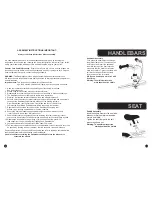
16
17
PART I
Figure 5. Interrupted Seat Tube
2. Front and Back Adjustment
The saddle can be adjusted forward or back to
help you get the optimal position on the bike.
Ask your dealer to set the saddle for your optimal
riding position and to show you how to make this
adjustment.
If you choose to make your own front and back
adjustment, make sure that the clamp mechanism
is clamping on the straight part of the saddle rails
and is not touching the curved part of the rails,
and that you are using the recommended torque
on the clamping fastener(s) (See manufacturer’s
instructions).
3. Saddle Angle Adjustment
Most people prefer a horizontal saddle; but some
riders like the saddle nose angled up or down just a
little. Your dealer can adjust saddle angle or teach
you how to do it.
If you choose to make your own saddle angle
adjustment and you have a single bolt saddle clamp
on your seat post, it is critical that you loosen the
clamp bolt sufficiently to allow any serrations on
the mechanism to disengage before changing the
saddle’s angle, and then that the serrations fully
re-engage before you tighten the clamp bolt to
the recommended torque (See manufacturer’s
instructions).
NOTE: If your bicycle is equipped with a suspension
seat post, periodically ask your dealer to check it.
Ask
your dealer for recommended service intervals for
your suspension seat post.
Small changes in saddle position can have a
substantial effect on performance and comfort.
To find your best saddle position, make only one
adjustment at a time.
WARNING
When making saddle angle adjustments with a
single bolt saddle clamp, always check to make
sure that the serrations on the mating surfaces
of the clamp are not worn. Worn serrations on
the clamp can allow the saddle to move, causing
you to lose control and fall.
Always tighten fasteners to the correct torque.
Bolts that are too tight can stretch and deform.
Bolts that are too loose can move and fatigue.
Either mistake can lead to a sudden failure of
the bolt, causing you to lose control and fall.
WARNING
After any saddle adjustment, be sure that
the saddle adjusting mechanism is properly
tightened before riding. A loose saddle clamp or
seat post binder can cause damage to the seat
post, or can cause you to lose control and fall.
A correctly tightened saddle adjusting
mechanism will allow no saddle movement in
any direction. Periodically check to make sure
that the saddle adjusting mechanism is properly
tightened.
(continued on next page...)
















































